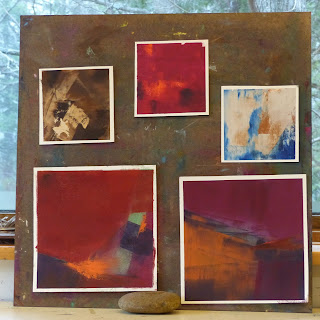My workshops are filled with (mostly) women, who are in the 50-75 year-old range. They are coming to art with a vengeance and an impatience, having recently discovered or rediscovered their creativity after years of working in other jobs. On the one hand, it's a huge pleasure to teach them because of their burning desire to learn. On the other, many appear to be under an enormous amount of pressure. Time pressure.
There is a sense that they don't have time to waste.
 |
| Christine Brutin |
 |
| Linda Virio |
 |
| Sharon Helleman |
How can I teach them to slow down, to have patience with themselves, with the process?
One exercise I do, if I'm teaching in a beautiful location, is to have the students go outside first thing in the morning. I ask them to pick a spot where they will sit for 20 minutes each day while asking themselves some contemplative questions. Then they come quietly into the studio and do 4 small paintings.
 |
| Anne Jackson |
One of the women in the class I taught last week, found a quiet spot to sit for the 20 minutes each day in the forest behind my studio. In the silence of the woods, she was able to make a connection with an old tree nearby. She wrote this heartfelt poem:
From the Forest
Moss-softened with years,
this tree, enduring and naked
after its leaves have blown,
gossamer light and free,
back to the ground of our being,
Stands. Tall.
Roots reach toward scorching,
feed saplings and silently call through the field,
I am here.
We are here.
Interdependent.
As limbs stretch toward sky,
seeding the clouds,
prompting the rain
to grow and maintain
this forest,
this tree
receives me.
Patricia Pidoux
Patricia Pidoux
Another way I begin the day is by reading from poets such as John O'Donohue or Mary Oliver or David Whyte.
But then we begin painting, and mindfulness gets lost in the pressure of things.
How can we hold onto that?
"I am not the endless chatter in my head. I am the me who recognizes that chatter is happening. I am not the me who is impatient in the grocery line or at the stoplight. I am the me who recognizes and acknowledges that impatience. If I take a breath and change the chatter to "This is me waiting calmly," that is what the experience becomes. Practising this simple awareness allows me to be present in all moments, to fully inhabit my life." Richard Wagamese, from the book Embers.
 |
| Oxanna Adams |
"I am not the endless chatter in my head. I am the me who recognizes that chatter is happening. I am not the me who is impatient in the grocery line or at the stoplight. I am the me who recognizes and acknowledges that impatience. If I take a breath and change the chatter to "This is me waiting calmly," that is what the experience becomes. Practising this simple awareness allows me to be present in all moments, to fully inhabit my life." Richard Wagamese, from the book Embers.


Beautiful post and a great reminder to be with the art and let it happen. You are teaching more than art, may be an artful life.
ReplyDeleteThanks Ruth for your comments. Art and life aren't separate, so yes, that's what I like to teach.
Delete